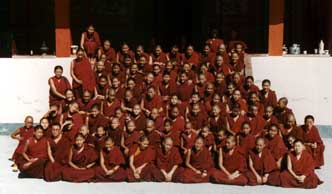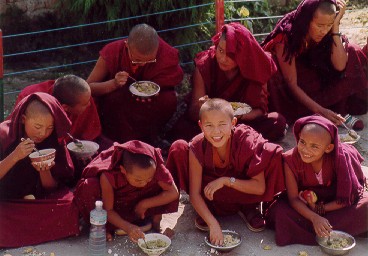| Nuns of Khachoe Ghakyil Women's Freedom and Spiritual Liberation: 2000 European Tour |
| The Khachoe
Ghakyil nuns: women and innovation in Tibetan culture
|
The North American tour of the nuns of Khachoe Ghakyil Nunnery (KGN) typifies the remarkable efforts made by the Tibetan people to preserve and reconstitute their rich culture following the takeover of Tibet by the Communist Chinese. From the beginning of their exile, the preservation of religion and culture was identified by the Dalai Lama as the foremost task confronting the exile community in India and Nepal. But the Tibetan people have chosen not merely to preserve the fixed forms of their ancient traditions, but to regenerate and adapt them to the new world in which they find themselves. It is this dynamic union of pure tradition with creative innovation that has empowered the Tibetan community in exile, and has inspired so much admiration and interest from the outside world. The tour of the Khachoe Ghakyil nuns is a perfect example of this vital process of innovative cultural preservation. In old Tibet there were many nunneries, but they carried on as poor sisters, always in the shadows of the great monasteries, which were filled with thousands of monks and led by famous, learned lamas. |
| The nuns rarely had
access to the variety of personal spiritual expression that was open to the monks,
including the study of Buddhist philosophy and debate, and training in the ritual arts of
music, dance, sand mandala construction, and thangka painting. In contrast to this rich curriculum at the monasteries, by and large the nunneries were limited to ritual recitation. The daily practice of meditative rituals is one of the core practices of all Tibetan Buddhists, and is not in itself limiting, as it holds the potential to lead the practitioner to ultimate awakening or Buddhahood. Nevertheless, the traditional path for monks began with some twenty years of scholastic training, through the medium of textual study and debate; and that was followed by a period of training in meditative practices which included training in the ritual arts. Nuns, on the other hand, were not provided with the vast and profound training in Buddhist thought that formed the basis of a monk’s education, in much the same way that women in the West rarely gained access to higher education until the twentieth century. In addition, because the social status and material resources of the nunneries in Tibet were miniscule compared to the great monasteries, very few were able to reconstitute themselves in India and Nepal when the Tibetan people fled their homeland. |
About the nunsKhachoe Ghakyil Nunnery (KGN), however, is one of a new generation of nunneries established in exile in Nepal and India. Located near the sacred Buddhist town of Boudhanath in Nepal's Kathmandu valley, KGN was founded in 1986 under the direction of Lama Thubten Zopa Rinpoche, Spiritual Director of the Foundation for the Preservation of the Mahayana Tradition (FPMT). It is now home to some 220 Tibetan Buddhist nuns ... with a steady flow of eager applicants continuing to request admittance. |
 |
| The nuns of KGN have
had the doors of the classical Buddhist education opened to them. They are provided with
highly trained scholars as their teachers, and they memorize texts, study, and debate in
the grand tradition of Tibetan monastic culture. Not surprisingly, once given access to scholastic training, Tibetan nuns have shown an intense determination to excel in their studies. In fact, there is a legend that centuries ago Tibetan nuns were educated in philosophy and debate. But one day a brilliant young nun defeated a famous scholar in the debate courtyard of his own monastery. Soon there came down an edict that henceforth nuns were not to be trained in debate! |
 |
This story may be
apocryphal, but the current suppression of religious freedom inside Tibet has caused
hundreds of nuns to flee Tibet in recent years. This influx of nuns seeking religious
freedom has brought a rapid increase in the population of the nunnery from the original
five nuns to the current count of two hundred, with many others seeking to join. One of the primary reasons for their North American tour is to raise funds so that facilities can be expanded to meet the ever-increasing needs of these new arrivals. (During the 1999 North American tour, the population of KGN went up by ten per cent!) |
Boudhanath |
The Khachoe Ghakyil
nuns take part in a complete study program alongside their brother monks from Kopan, an
affiliated monastery located nearby. Their studies include
Tibetan and English language, mathematics, philosophy, meditation, debate, traditional rituals, chanting and
art, along with other teachings and practice of the Buddha. Their goal is to
become qualified Dharma teachers so that they may teach others, and to become economically
self-sufficient. There are plans at Kopan to establish a geshe program of its own (the geshe degree is the monastic equivalent of a Doctor of Divinity). When this becomes a reality, many of the nuns at Khachoe Ghakyil expect to enroll in the geshe program - the first such program ever to include nuns as well as monks. Until now, the opportunity to study and receive a geshe degree has been restricted to monks living at the monastic universities. This is an especially welcome development! |
| The nuns' tour | Traditionally, ritual arts and scholastic study have been a prerogative of Tibetan Buddhist monks, with their ordained sisters receiving little or no training in these areas. In the Tibetan community-in-exile, however, this is changing. Nuns are now training in classical Tibetan debate, the performance of ritual music, the creation of sand mandalas, and other ritual arts. This tour will be the first opportunity for most North Americans to see the accomplishments of this first generation of newly-trained young nuns. (Please see the performance page for more details of the tour program.) |
| In
addition, however, the tour has been organised to raise money to support the nuns of
Khachoe Ghakyil, most of whom are refugees from Tibet. The nunnery started when
five nuns arrived at Kopan. Eventually so many nuns arrived that a new facility,
Khachoe Ghakyil Ling Nunnery, was built especially for them. However, there are more
and more nuns requesting that they be allowed to join the nunnery; and plans are now being
made to arrange facilities and accommodations for another 100 residents. Lama Zopa Rinpoche, the spiritual director of the FPMT, wrote an open letter in support of the Khachoe Ghakyil tour in the Jan-Feb 99 issue of the FPMT's Mandala Magazine. |
|
| What does Khachoe Ghakyil mean? |
...hence the name of the nuns' new CD recording: The Bliss Swirl of the Sky Dancers. (Just a note: if you have trouble pronouncing Khachoe Ghakyil, say "Catcher gah keel" instead. That will be close enough!) |
| Related links | On Khachoe Ghakyil:
On Tibetan Buddhist nuns:
|
Sacred
performance | Ritual music | Sand
mandalas | The nuns of KGN | Image
gallery
CD recording | European tour itinerary
(in German) | Info for organizers | Support the nuns! | Related links
© Khachoe Ghakyil 1999-2002
Web custodian Julia Milton
Hosted by Women Active in Buddhism.